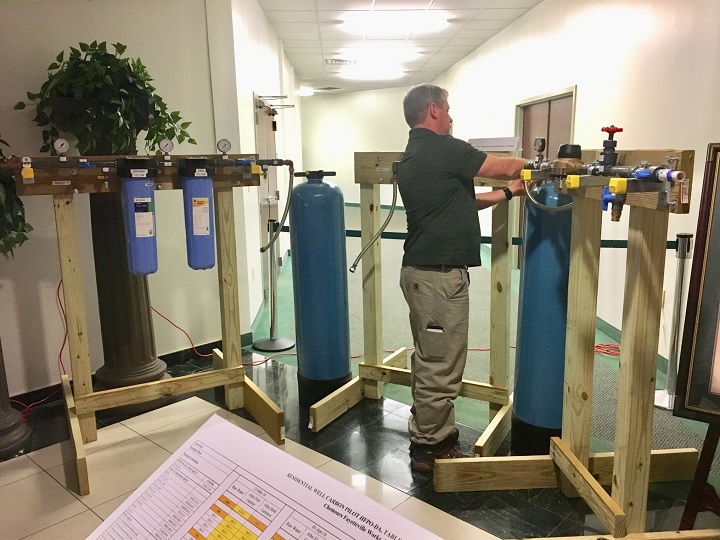
Reprinted from North Carolina Health News
Not all types of in-home filters are completely effective at removing “forever chemicals” from drinking water, and a few could do more harm than good if not properly maintained, according to a new study released Wednesday by North Carolina researchers.
Supporter Spotlight
Water filters in refrigerators, pitcher-style filters, under the sink reverse osmosis systems and whole-house filtration systems can function differently and have vastly different price tags, according to the study, headed by the researchers from Duke University and North Carolina State University.
Researchers tested 76 drinking water filtration systems to determine their ability to remove toxic perfluoroalkyl substances, commonly known as PFAS, in homes in Chatham, Orange, Durham and Wake counties in central North Carolina. They also tested in homes in New Hanover and Brunswick counties in the southeastern part of the state.
The conclusion is that “their effectiveness varied widely,” said Heather Stapleton, an associate professor of Environmental Health at Duke’s Nicholas School of the Environment and a lead researcher in the study. But researchers say having a filter is better than not having one.
Reverse osmosis works best
Stapleton said the study, published Wednesday in Environmental Science & Technology Letters, found that reverse osmosis filters work best. They reduced GenX and other PFAS by 94% or more, according to a news release provided to reporters from across the state who attended a panel discussion at Duke University titled “Safeguarding the Water We Drink: Understanding the Science Behind Emerging Threats to N.C.’s Drinking Water.”
Activated carbon filters, such as those found in refrigerators and pitcher-style filtration systems, on average, removed 73% of PFAS contaminants, but the results varied widely.
Supporter Spotlight
“In some cases, the chemicals were completely removed; in other cases, they were not reduced at all,” according to the release. “Researchers saw no clear trends between removal efficiency and filter brand, age or source water chemical levels. Changing out filters regularly is probably a very good idea, nonetheless.”
In contrast to reverse osmosis filters, Stapleton said in the release, “the effectiveness of activated-carbon filters used in many pitcher, countertop, refrigerator and faucet-mounted styles was inconsistent and unpredictable. The whole house systems were also widely variable and in some cases actually increased PFAS levels in the water.”
N.C. first to study filters’ effectiveness
The study was the first to examine the efficiency of filtration devices in removing a slate of PFAS in homes. Its authors said the discrepancies in effectiveness and cost may make it harder for people concerned about the contaminants in their drinking water to know which system best suits their needs and budgets.
“The under-sink reverse osmosis filter is the most efficient system for removing both the PFAS contaminants prevalent in central N.C. and PFEAs, including GenX, found in Wilmington,” Detlef Knappe, an N.C. State professor, said in the release. “Unfortunately, they also cost much more than other point-of-use filters.
“This raises concerns about environmental justice, since PFAS pollution affects more households that struggle financially than those that do not.”
Knappe, a co-author of the study, called home filters “a stop-gap” measure.
“The real goal should be control of PFAS contaminants at their source,” he said.

5,000 types of PFAS
There are an estimated 5,000 different types of PFAS, which have come under scrutiny in recent years because of their potential harm to health and widespread presence in the environment, especially in drinking water. Long-term exposure to PFAS is associated with various cancers, low birth weight, thyroid disease, impaired immune function and other health problems.
North Carolina is said to have the third-worst problems with PFAS of any state in the country. The Washington-based Environmental Working Group released a study last month that found Brunswick County had the highest level of total PFAS from samples of tap water taken at 44 locations in 31 states.
Data released last month by the N.C. Department of Environmental Quality found much higher levels of PFAS being discharged into rivers and streams from some sewer treatment plants in the Cape Fear River basin. Samples taken in September at Sanford’s sewer plant detected total PFAS measuring 4,026 parts per trillion. In Burlington, total PFAS measured 2,296 parts per trillion in August.
Although the DEQ did not sample for PFAS in drinking water, it is evident that the contamination is present in tap water in many communities in the river basin. Data out of Fayetteville show a contamination spike of 244 parts per trillion of total PFAS in its drinking water in September.
The federal Environmental Protection Agency has set a health advisory on only two types of PFAS — known as PFOA and PFOS. Under those guidelines, a person who consistently consumes 70 parts per trillion of either chemical, or a combination of them both, stands an increased risk of cancer and other adverse health effects.
Knappe said after the meeting that he would like to see North Carolina lower its health advisory for PFOA and PFOS to be more in line with what other states are doing, particularly New Jersey and Michigan. Health officials in those states have proposed advisories of only 13 parts per trillion or less. The Environmental Working Group proposes an even lower advisory level: 1 part per trillion for all PFAS.
Other water pollution problems highlighted
Joining Stapleton and Knappe on the panel Wednesday were Duke University environmental professors Avner Vengosh and Lee Ferguson.
Vengosh spoke about high levels of heavy metals and other contaminants being found at the bottom of Sutton Lake, which was once used by Duke Energy to cool a coal-burning power plant. Toxic levels of contaminants have been found in the lake’s fish, Vengosh said.
Vengosh also spoke about a study released in November that he co-authored that found potentially harmful levels of hexavalent chromium in more than half of 1,400 wells tested in the central part of the state. Hexavalent chromium, a known carcinogen, occurs naturally in groundwater. It is also found in coal ash.
Ferguson spoke about the North Carolina PFAST Network’s sampling of all of the municipal drinking water supplies in the state. Although the second round of testing continues, Ferguson said high levels of PFAS have been detected in seven water systems — for Brunswick, New Hanover, Pender and Orange counties, Wrightsville Beach, Maysville, and International Paper Co.
The network is part of the North Carolina Policy Collaboratory. It was created in 2018 with a $5 million grant from the legislature to assess PFAS contamination statewide. Ferguson serves as a network director.
He said after the meeting that the contaminants found in Orange County’s drinking water were barely above the EPA’s health advisory, and the county has taken action to keep the contaminants low. He said Wrightsville Beach has corrected its problem and Maysville is getting water from neighboring Jones County.
This story is provided courtesy of North Carolina Health News, a website covering health and environmental news in North Carolina. Coastal Review Online is partnering with North Carolina Health News to provide readers with more environmental and lifestyle stories of interest about our coast.







